Few things betray one’s age more than a saggy bottom. An angelic face, ironing board stomach and ballet dancer’s legs can all be betrayed with buttocks like pancakes. The answer can be found in an expensive buttock lift – or absolutely free and regular buttock lifts.
Here are four top bottom exercises, three classic and one my own compound creation, which will help tone up even the flattest of derrieres. Just pick the exercises you prefer, based on your time and ability, and spend 5-15 minutes each day doing them after you have sufficiently warmed up. By all means use music if you prefer, something at around 125 beats per minute.
Add a set to each exercise every week, and after four weeks you could start noticing the difference. If not buns of steel, then at least more buns than crepes!
These are the classic lunge, squat and donkey kicks, and the super-toning “round the world” leg lifts for the buttocks, thighs and hamstrings. (Don’t forget to stretch out at the end!)
1. The Lunge
Stand with the feet hip-width apart and toes facing forwards. Ideally, step forward far enough so that both knees can bend at a right angle as the body is lowered or as far as your knees feel able. Return to the starting position and repeat the movement on the other leg.
Don’t forget to keep the body upright, and the toes pointing forward and hip-width apart to maintain your balance. Look forwards and slightly down, relaxing the shoulders and arms, and ensuring the trailing knee does not touch the floor. Drive back with the front leg to the starting position.
Repeat for eight, 16, 24 or 32 times on each leg. If balance is a problem, all the repetitions can be completed on one leg at a time. A handrail can also be held, if necessary, but only for balance and not to support the movement. To increase the intensity of the exercise, hand weights can be used.
2. The Squat
Stand with the feet hip-width apart or slightly wider, with the feet facing forwards or slightly outwards. The trunk should be upright and the knees slightly bent.
Lower by bending at the knees and hips, ensuring the back remains upright with the shoulders lowered in a vertical line and the head facing forwards. Squat only to a position where the thighs are roughly parallel to the ground to maintain balance and help protect the knees.
Ensure the knees stay in line with the feet and do not go beyond them. The heels should stay in contact with the floor.
Return to the upright position by straightening the hips and knees, without locking out the latter. Make the entire action smooth and continuous, and repeat for eight, 16, 24 or 32 squats.
3. Donkey Kicks
Facing downwards on a matt or towel, position yourself like a table. Your forearms and knees are the “legs,” supporting your bodyweight, and your trunk is the “table top,” with the stomach muscles braced, and parallel to the floor.
Keeping both hips square and facing downwards, lift one leg so it is in line with the body. Then bend the knee at a 90-degree angle and flex the foot so the heel is the highest point. This is the starting position. Keep the head in line with the trunk and facing downwards, and the shoulders square to the floor.
With a small, steady and continuous movement, push directly up through the heel. The lower leg should remain vertical, while the thigh lifts up about 20 degrees. Then lower the heel and thigh to the starting position and repeat the movement. You should feel the effort in the thigh, hamstring, buttock and calf.
Ensure the hips remain squarely facing downwards. That way, the effort is also felt in the opposing buttock. Do not arch the spine, keeping the back in the “table top” position. The only part of the body that should move is the raised leg.
Repeat for eight, 16, 24 or 32 lifts. Change legs and repeat for the same number.
4. Around The World Leg Lifts
Position yourself as for a donkey kick except keep the raised leg straight and in line with the body, with the foot flexed and toes facing the floor. This is starting position No.1.
Again, using small, steady and continuous movements, lift the leg so the thigh raises around 20 degrees, and then return to the starting position. Remember to maintain the “table top” body position throughout. Do not arch the back. The only movement should come from the raised leg. Repeat for eight raises.
Without lowering the leg to the floor, remain at the first starting position and turn the foot and leg out so the whole of the foot is parallel to the floor and the knee is facing the wall. The rest of the body remains in the same position. This is starting position No.2. Then lift the leg as before, this time feeling the effort in the inside of the thigh and outside of the buttock. Repeat for eight raises.
If you are a beginner, turn the leg and foot back to the No.1 position and repeat the original eight lifts. Then return to the No.2 position and repeat for another eight. This way, the raises can be completed in sets of 16, 32, 48 or 64.
For intermediate and advanced exercisers, hold the No.2 starting position. Without touching the floor, bring the raised leg around to the side so it is at a right angle to the body, or as far across as you can manage. The leg remains at body height and straight with the foot flexed. The body position is also the same, with a “table top” trunk, and the hips and shoulders facing squarely downwards.
This time, using very small controlled movements, raise the whole leg slightly. Repeat for eight or 16 lifts, then briefly lower the foot to the floor if necessary. Otherwise, to maintain the intensity, keep it raised and return it to the No.2 position for eight lifts, then the No.1 position for another eight lifts. In total, there are 40-48 lifts.
Then relax, tucking the knees up under the body for 15-30 seconds to stretch out those well-exercised buns. And then repeat the whole sequence on the other leg! Challenging, yes. Worth it? Grab a couple of mirrors and check out that rear view to find out!

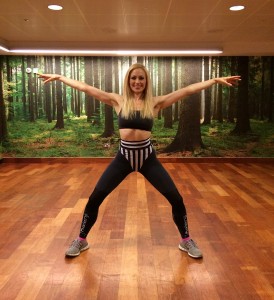
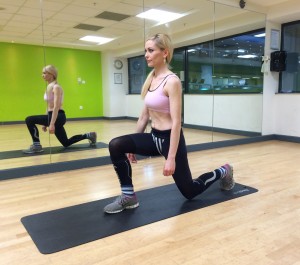
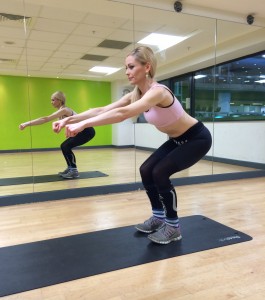
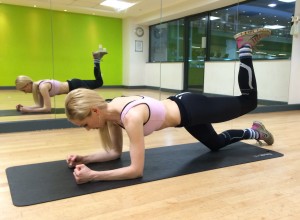
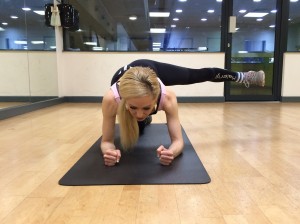
Comments are closed.